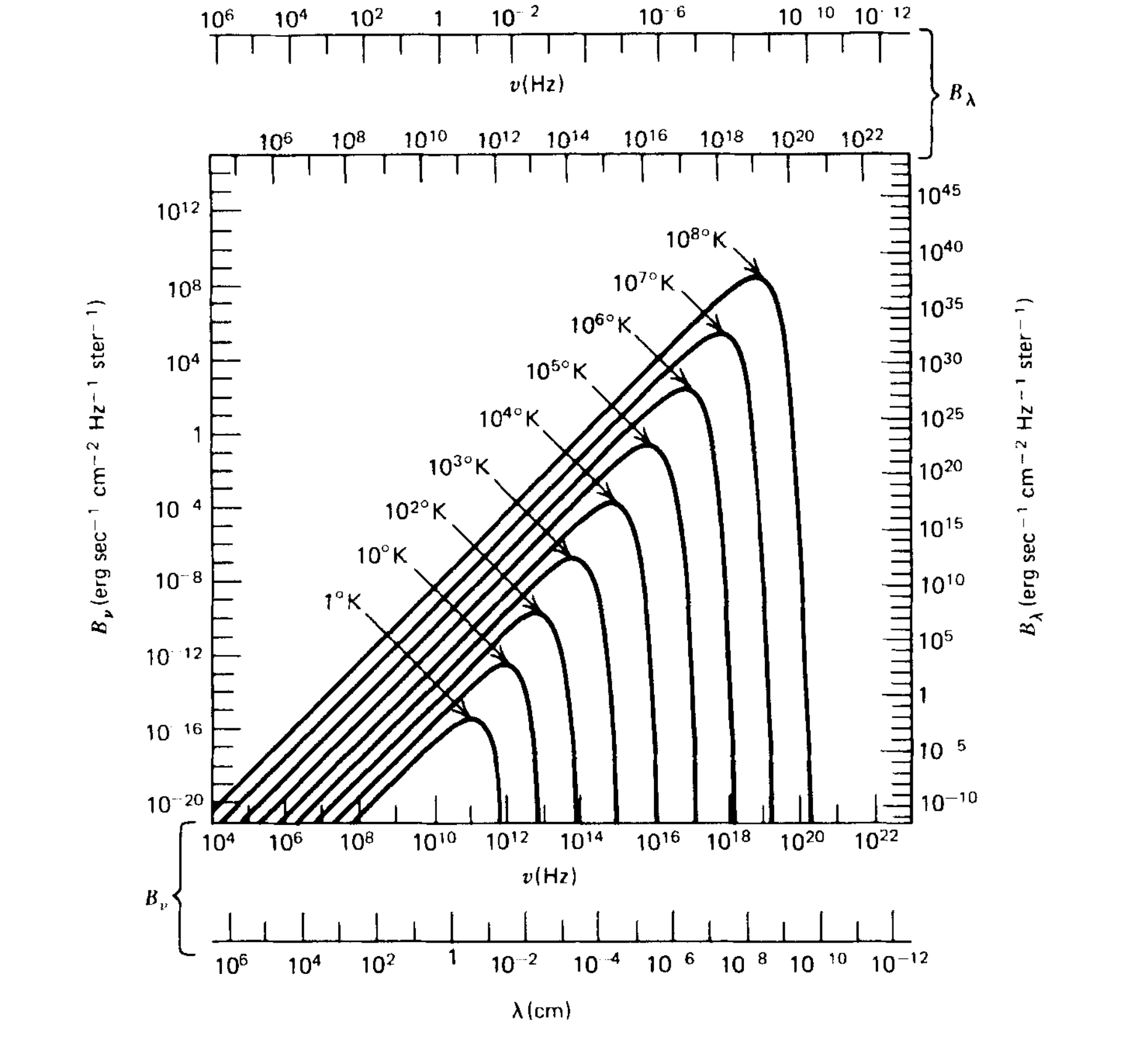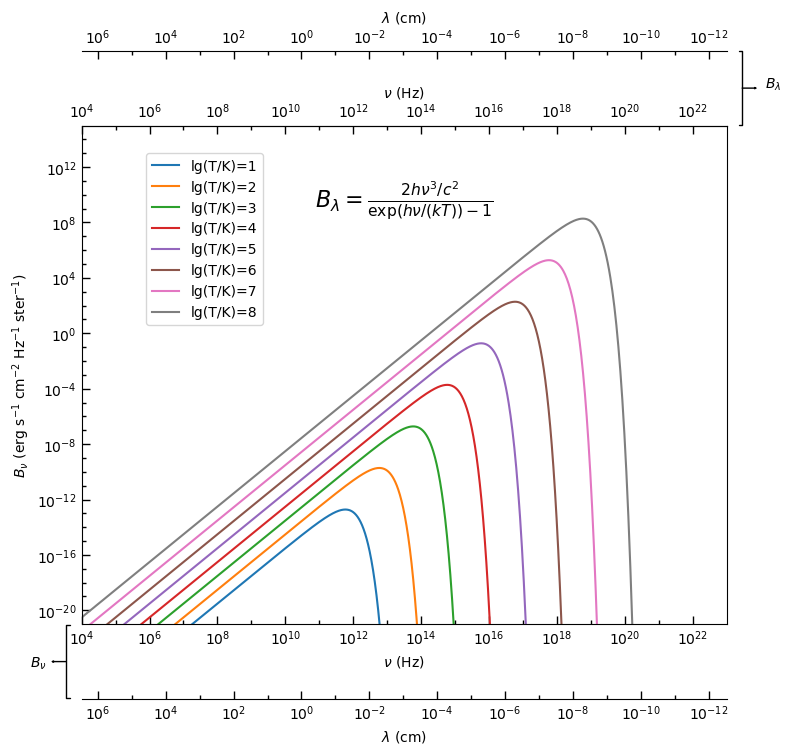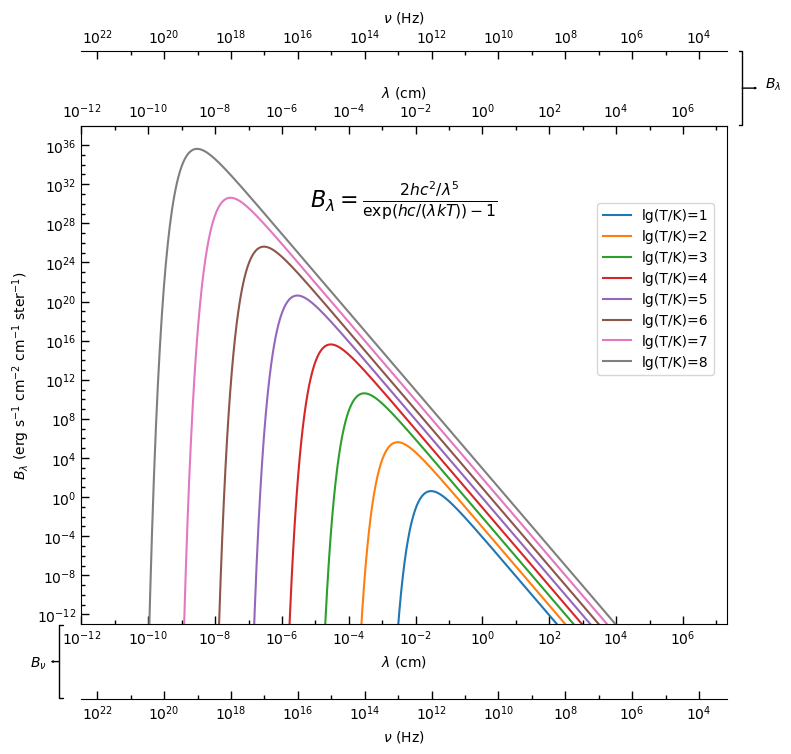How to plot a secondary axis with Matplotlib
Import packages
python
# -*- coding: utf-8 -*-
"""
@Author: Guan-Fu Liu
Created on Oct. 5, 2023
Last modified on Oct. 5, 2023
To create sencondary axes in matplotlib.
"""
import matplotlib.pyplot as plt
import numpy as np
from astropy import constants as const
import pandas as pd
# %matplotlib widgetTo reproduce Fig. 11 in Radiative Processes in Astrophysics, by George B. Rybicki, Alan P. Lightman, pp. 400. ISBN 0-471-82759-2. Wiley-VCH , June 1986.

Define some constants
These constants are only needed in this example.
python
# All the constants are in cgs units.
h = const.h.cgs.value
c = const.c.cgs.value
kB = const.k_B.cgs.valueDefine the transform between the primary and secondary axes
It is a must.
python
def nu_to_lambda(nu):
"""
Convert frequency to wavelength.
Parameters
----------
nu : float
Frequency in Hz.
"""
return c/nu
def lambda_to_nu(lam):
"""
Convert wavelength to frequency.
Parameters
----------
lam : float
Wavelength in cm.
"""
return c/lam
def B_nu_to_B_lambda(B_nu, nu):
"""
Convert specific intensity from B_nu to B_lambda.
Parameters
----------
B_nu : float
Specific intensity in B_nu.
nu : float
Frequency in Hz.
"""
return B_nu*nu**2/cpython
Ts = np.logspace(1, 8, 8)
T_indices = ['lg(T/K)=%d'%a for a in range(1, 9)]
df = pd.DataFrame(columns=['nu', 'lambda', 'B_nu', 'B_lambda'], index=T_indices)
for i in range(len(Ts)):
T = Ts[i]
alpha = np.log10(T) + 1
nu = np.logspace(9.0-0.9*alpha, 11.5+1*alpha, 1000)
B_nu = 2*h*nu**3/c**2/(np.exp(h*nu/kB/T)-1)
B_lambda = B_nu*nu**2/c
lambda1 = c/nu
df.iloc[i] = [nu, lambda1, B_nu, B_lambda]python
# Pre-defined line styles for plotting.
linestyles = [
('loosely dotted', (0, (1, 10))),
('dotted', (0, (1, 1))),
('densely dotted', (0, (1, 1))),
('long dash with offset', (5, (10, 3))),
('loosely dashed', (0, (5, 10))),
('dashed', (0, (5, 5))),
('densely dashed', (0, (5, 1))),
('loosely dashdotted', (0, (3, 10, 1, 10))),
('dashdotted', (0, (3, 5, 1, 5))),
('densely dashdotted', (0, (3, 1, 1, 1))),
('dashdotdotted', (0, (3, 5, 1, 5, 1, 5))),
('loosely dashdotdotted', (0, (3, 10, 1, 10, 1, 10))),
('densely dashdotdotted', (0, (3, 1, 1, 1, 1, 1)))]Plot
python
fig, ax = plt.subplots(figsize=(8, 8))
ax.loglog()
for index, row in df.iterrows():
ax.plot(row['nu'], row['B_nu'], label=index)
# Set x and y limits
ax.set_xlim(1e4, 1e23)
ax.set_ylim(1e-21, 1e15)
# Set x major ticks
major_xticks = np.logspace(4, 22, 10)
ax.set_xticks(major_xticks, minor=False)
# If all the x or y major ticks are something like "1e5", "1e6", "1e7" etc.,
# you may not need to set the x major tick labels.
# Matplotlib will automatically set the x major tick labels as "$\\mathdefault{10^{5}}$",
# "$\\mathdefault{10^{6}}$", "$\\mathdefault{10^{6}}$" etc.
# Set x minor ticks
minor_xticks = np.logspace(5, 21, 9)
ax.set_xticks(minor_xticks, minor=True)
# Set x minor tick labels
ax.set_xticklabels([' ']*len(minor_xticks), minor=True)
# Set tick parameters
ax.tick_params(axis='x', direction='in',which='major', length=6, width=1.0)
ax.tick_params(axis='x', direction='in',which='minor', length=3, width=1.0)
# Set y major ticks
major_yticks = np.logspace(-20, 12, 9)
ax.set_yticks(major_yticks, minor=False)
# Set y minor ticks
minor_yticks = np.logspace(-20, 14, 35)
ax.set_yticks(minor_yticks, minor=True)
# Set y minor tick labels
ax.set_yticklabels(['']*len(minor_yticks), minor=True)
# Set tick parameters
ax.tick_params(axis='y', direction='in',which='major', length=6, width=1.0)
ax.tick_params(axis='y', direction='in',which='minor', length=3, width=1.0)
# Set x and y labels
ax.set_xlabel(r'$\nu$ (Hz)')
ax.set_ylabel(r'$B_\nu$ (erg s$^{-1}$ cm$^{-2}$ Hz$^{-1}$ ster$^{-1}$)')
# Set secondary x axis on the top
secax1 = ax.secondary_xaxis(location='top', functions=(lambda x: x, lambda x: x))
# Set secondary x axis ticks and labels
secax1.set_xticks(ax.get_xticks(minor=False), minor=False)
secax1.set_xticklabels(ax.get_xticklabels(minor=False), minor=False)
secax1.set_xticks(ax.get_xticks(minor=True), minor=True)
secax1.set_xticklabels(ax.get_xticklabels(minor=True), minor=True)
secax1.set_xlabel(ax.get_xlabel())
# Set tick parameters
secax1.tick_params(axis='x', direction='in',which='major', length=6, width=1.0)
secax1.tick_params(axis='x', direction='in',which='minor', length=3, width=1.0)
# Set secondary x axis on the top, but in the unit of wavelength
secax2 = ax.secondary_xaxis(location=1.15, functions=(nu_to_lambda, lambda_to_nu))
# Set secondary x axis ticks and labels
major_xticks2 = np.logspace(6, -12, 10)
secax2.set_xticks(major_xticks2, minor=False)
minor_xticks2 = np.logspace(5, -11, 9)
secax2.set_xticks(minor_xticks2, minor=True)
secax2.set_xticklabels(['']*len(minor_xticks2), minor=True)
secax2.set_xlabel(r'$\lambda$ (cm)')
# Set tick parameters
secax2.tick_params(axis='x', direction='in',which='major', length=6, width=1.0)
secax2.tick_params(axis='x', direction='in',which='minor', length=3, width=1.0)
# Set secondary x axis limits
secax2.set_xlim(secax1.get_xlim())
# Set secondary x axis on the top, but in the unit of wavelength
secax3 = ax.secondary_xaxis(location=-0.15, functions=(nu_to_lambda, lambda_to_nu))
# Set secondary x axis ticks and labels
major_xticks3 = np.logspace(6, -12, 10)
secax3.set_xticks(major_xticks3, minor=False)
minor_xticks3 = np.logspace(5, -11, 9)
secax3.set_xticks(minor_xticks3, minor=True)
secax3.set_xticklabels(['']*len(minor_xticks3), minor=True)
secax3.set_xlabel(r'$\lambda$ (cm)')
# Set tick parameters
secax3.tick_params(axis='x', direction='in',which='major', length=6, width=1.0)
secax3.tick_params(axis='x', direction='in',which='minor', length=3, width=1.0)
# Set secondary x axis limits
secax3.set_xlim(secax1.get_xlim())
# Add annotation
ax.annotate('', xytext=(1.02, 1.075), xy=(1.05, 1.075), xycoords='axes fraction',
arrowprops=dict(arrowstyle="]->, widthA=12, lengthA=1.2", color='black', mutation_scale=2.2,
connectionstyle="arc3", lw=1.0, mutation_aspect=1, shrinkB=1))
ax.annotate(r'$B_{\lambda}$', xytext=(1.06, 1.075), xy=(1.09, 1.075), xycoords='axes fraction')
ax.annotate('', xytext=(-0.02, -0.075), xy=(-0.05, -0.075), xycoords='axes fraction',
arrowprops=dict(arrowstyle="]->, widthA=12, lengthA=1.2", color='black', mutation_scale=2.2,
connectionstyle="arc3", lw=1.0, mutation_aspect=1, shrinkB=1))
ax.annotate(r'$B_{\nu}$', xytext=(-0.08, -0.085), xy=(-0.06, -0.085), xycoords='axes fraction')
ax.text(0.5, 0.85, r'$B_{\lambda}=\frac{2h\nu^{3}/c^{2}}{\exp(h\nu/(k T))-1}$', horizontalalignment='center',
verticalalignment='center', transform=ax.transAxes, fontsize=16)
ax.legend(loc=(0.1, 0.6))
fig.tight_layout()
fig.savefig('Bnu.png', dpi=300, bbox_inches='tight')
plt.show()
python
fig, ax = plt.subplots(figsize=(8, 8))
ax.loglog()
for index, row in df.iterrows():
ax.plot(row['lambda'], row['B_lambda'], label=index)
ax.set_xlim(1e-12, 2e7)
ax.set_ylim(1e-13, 1e38)
# Set x major ticks
major_xticks = np.logspace(-12, 6, 10)
ax.set_xticks(major_xticks, minor=False)
# Set x minor ticks
minor_xticks = np.logspace(-11, 7, 10)
ax.set_xticks(minor_xticks, minor=True)
# Set x minor tick labels
ax.set_xticklabels([' ']*len(minor_xticks), minor=True)
# Set tick parameters
ax.tick_params(axis='x', direction='in',which='major', length=6, width=1.0)
ax.tick_params(axis='x', direction='in',which='minor', length=3, width=1.0)
# Set y major ticks
major_yticks = np.logspace(-12, 36, 13)
ax.set_yticks(major_yticks, minor=False)
# Set y minor ticks
minor_yticks = np.logspace(-12, 36, 49)
ax.set_yticks(minor_yticks, minor=True)
# Set y minor tick labels
ax.set_yticklabels(['']*len(minor_yticks), minor=True)
# Set tick parameters
ax.tick_params(axis='y', direction='in',which='major', length=6, width=1.0)
ax.tick_params(axis='y', direction='in',which='minor', length=3, width=1.0)
# Set x and y labels
ax.set_xlabel(r'$\lambda$ (cm)')
ax.set_ylabel(r'$B_\lambda$ (erg s$^{-1}$ cm$^{-2}$ cm$^{-1}$ ster$^{-1}$)')
# Set secondary x axis on the top
secax1 = ax.secondary_xaxis(location='top', functions=(lambda x: x, lambda x: x))
# Set secondary x axis ticks and labels
secax1.set_xticks(ax.get_xticks(minor=False), minor=False)
secax1.set_xticklabels(ax.get_xticklabels(minor=False), minor=False)
secax1.set_xticks(ax.get_xticks(minor=True), minor=True)
secax1.set_xticklabels(ax.get_xticklabels(minor=True), minor=True)
secax1.set_xlabel(ax.get_xlabel())
# Set tick parameters
secax1.tick_params(axis='x', direction='in',which='major', length=6, width=1)
secax1.tick_params(axis='x', direction='in',which='minor', length=3, width=1)
# Set secondary x axis on the top, but in the unit of wavelength
secax2 = ax.secondary_xaxis(location=1.15, functions=(lambda_to_nu, nu_to_lambda))
# Set secondary x axis ticks and labels
major_xticks2 = np.logspace(4, 22, 10)
secax2.set_xticks(major_xticks2, minor=False)
minor_xticks2 = np.logspace(5, 21, 9)
secax2.set_xticks(minor_xticks2, minor=True)
secax2.set_xticklabels(['']*len(minor_xticks2), minor=True)
secax2.set_xlabel(r'$\nu$ (Hz)')
# Set tick parameters
secax2.tick_params(axis='x', direction='in',which='major', length=6, width=1.0)
secax2.tick_params(axis='x', direction='in',which='minor', length=3, width=1.0)
# Set secondary x axis limits
secax2.set_xlim(secax1.get_xlim())
# Set secondary x axis on the bottom, but in the unit of wavelength
secax3 = ax.secondary_xaxis(location=-0.15, functions=(lambda_to_nu, nu_to_lambda))
# Set secondary x axis ticks and labels
major_xticks3 = np.logspace(4, 22, 10)
secax3.set_xticks(major_xticks3, minor=False)
minor_xticks3 = np.logspace(5, 21, 9)
secax3.set_xticks(minor_xticks3, minor=True)
secax3.set_xticklabels(['']*len(minor_xticks3), minor=True)
secax3.set_xlabel(r'$\nu$ (Hz)')
# Set tick parameters
secax3.tick_params(axis='x', direction='in',which='major', length=6, width=1.0)
secax3.tick_params(axis='x', direction='in',which='minor', length=3, width=1.0)
# Set secondary x axis limits
secax3.set_xlim(secax1.get_xlim())
# Add annotation
ax.annotate('', xytext=(1.02, 1.075), xy=(1.05, 1.075), xycoords='axes fraction',
arrowprops=dict(arrowstyle="]->, widthA=12, lengthA=1.2", color='black', mutation_scale=2.2,
connectionstyle="arc3", lw=1.0, mutation_aspect=1, shrinkB=1))
ax.annotate(r'$B_{\lambda}$', xytext=(1.06, 1.075), xy=(1.09, 1.075), xycoords='axes fraction')
ax.annotate('', xytext=(-0.03, -0.075), xy=(-0.05, -0.075), xycoords='axes fraction',
arrowprops=dict(arrowstyle="]->, widthA=12, lengthA=1.2", color='black', mutation_scale=2.2,
connectionstyle="arc3", lw=1.0, mutation_aspect=1, shrinkB=1))
ax.annotate(r'$B_{\nu}$', xytext=(-0.08, -0.085), xy=(-0.06, -0.085), xycoords='axes fraction')
ax.text(0.5, 0.85, r'$B_{\lambda}=\frac{2hc^{2}/\lambda^{5}}{\exp(hc/(\lambda k T))-1}$', horizontalalignment='center',
verticalalignment='center', transform=ax.transAxes, fontsize=16)
ax.legend(loc=(0.8, 0.5))
plt.tight_layout()
fig.savefig('Blambda.png', dpi=300, bbox_inches='tight')
plt.show()